Final report for GS15-147
Project Information
The goal of this project was to investigate organic spring lettuce production under high tunnels compared to the open field in Georgia. We evaluated the effect of high tunnels, three planting dates and 12 cultivars (i.e., 6 butterhead and 6 romaine lettuce types) on lettuce yield. A greater marketable fresh weight for both butterhead and romaine lettuce was observed under high tunnels compared to the field in 2016 but not in 2015, indicating the advantage may depend on yearly weather conditions. The butterhead cultivar “Sylvesta” and the romaine cultivar “Green Forest” consistently performed well in both the high tunnels and field.
High tunnel lettuce was harvested 2 to 7 days earlier than the field depending on the year. The added protection from the high tunnel system plus row covers prevented the air temperature dropping below 32oF on freezing nights (i.e., 6-9°F greater in high tunnels) while maintaining approximately 1-2°F greater average daily air temperature compared to the field system, across the entire growing season. Other micro-environmental differences between two production systems included decreased leaf wetness and decreased photosynthetically active radiation under the high tunnel systems. Pests, diseases (e.g., Sclerotinia sclerotiorum) and physiological disorders were not different between the two systems.
In addition to the field study, a consumer survey was conducted to identify the lettuce preferences by shoppers at the Athens, GA farmers market. Participants answered questions about purchasing habits, visual appearance and rated the taste of four butterhead and/or romaine cultivars. The cultivars chosen represented those that performed the best under the high tunnels or had unique visual appeal. The majority of the participants ranked ‘freshness’, ‘taste’ and ‘visual appearance’ as the top three attributes affecting their lettuce purchases. Among the four butterhead cultivars, ‘Sylvesta’ received the top ranking while all four romaine cultivars evaluated, ‘Green Forest’, ‘Salvius’, ‘Super Jericho’ and ‘Red Rosie’ ranked similarly.
Introduction:
The goal of this project was to investigate organic spring lettuce production under high tunnels compared to the open field in Georgia. Many farmers are interested in capturing the local lettuce market and view high tunnel systems as a tool to achieve this goal. High tunnels can protect crops from extreme weather events (i.e., precipitation, frost, wind, cold) and result in better overall crop quality and earlier yields and is therefore is attractive (grower communication). NRCS high tunnel cost share programs have made this an even more attractive idea to explore. Between 2010 and 2014, NRCS awarded more than 480 awards to Georgia farmers for high tunnel construction.
The majority of current high tunnel literature is based in Northeast and North Central regions where the production challenges are different than the Southern region. There is a lack of recommendations for the Southern region even with the growing popularity of these systems. Rapidly fluctuating temperatures and a quick transition from spring to summer are typical challenges for high tunnel lettuce production in the South. Lettuce is a cool season crop with optimum day-time and night-time temperatures of 73°F and 45°F, respectively (Jackson et al., 1996); higher temperatures often result in physiological disorders including bolting (i.e., flowering), bitterness, tip-burn, and poor heading (Rader and Karlsson, 2006).
Many high tunnel studies have found increases in crop yield and quality (O’Connell et al., 2012; Rader and Karlsson, 2006; Waterer, 2003) but location, timing and crop selection are all factors to consider. Based on previous studies it appears the high tunnel environment can present unique challenges for lettuce production and may require a separate set of management practices including variety selection to perform optimally. Therefore, our study evaluates the performance of six butterhead and six romaine lettuce varieties in high tunnels compared to the field at three different spring planting dates. The varieties were chosen based on grower or seed company recommendations. Growing systems will be compared for effects on crop yield and quality and microclimate will be characterized for each system. Lastly, we conducted a consumer taste test and visual assessment of the top-performing varieties to better understand local market preferences.
1) Evaluate the effect of high tunnels on spring organic lettuce production in Georgia.
2) Compare the performance of different lettuce varieties in each growing system.
3) Assess the effect of three different planting dates on crop yield.
4) Describe the microclimate of each growing system throughout the spring season.
5) Conduct consumer taste test and visual assessment of the top-performing lettuce varieties to better understand market preferences.
Cooperators
Research
Study 1: Evaluation of high tunnel systems for spring organic lettuce production in Georgia
Site Characteristics and High Tunnel Design:
A comparison of lettuce (Lactuca sativa var capitata L. and Lactuca sativa var. logifolia Lam.) production in high tunnel production compared to field production was conducted during 2015 and 2016 at the Durham Horticulture Farm located in Watkinsville, GA). The USDA plant hardiness zone for the site is 8a. The project site has been USDA certified organic since 2012 and all agricultural production methods were performed under these guidelines.
Two commercial-size gothic-shaped high tunnels (Atlas Greenhouse Inc., Alapaha, GA) (96 ft x 30 ft) and an adjacent field area were used for the study (150 ft x 30 ft). High tunnels were constructed in an east-west orientation to be perpendicular to the prevailing winter winds at the site. Bows were spaced every 6 ft. The high tunnels had inflated double polythene film roofs comprised of 6 mil plastic. The end walls were comprised of ~0.3 inch thick polycarbonate. Automated 6 ft tall z-lock drop-down side curtains constructed from 12 mil weave fabric were utilized.
Three planting dates (PD) (2015: 3/12, 4/2, 4/23 and 2016: 3/3, 3/24, 4/14) were selected by studying the last 20 years of last frost dates at the project site. Lettuce cultivars were selected after consulting with local organic farmers and several seed companies for recommendations for heat tolerant and/or top performing cultivars for the region. A few cultivars (‘Freckles’ and ‘Red Rosie’) were included for visual interest. The six butterhead cultivars included were: ‘Red Cross’, ‘Sylvesta’, ‘Adriana’, ‘Skyphos’ (Johnny's Selected Seeds), ‘Pirat’, and ‘Mirlo’ (High Mowing Seeds). The six romaine cultivars included were: ‘Salvius’, ‘Coastal Star’, ‘Green Forest’, ‘Red Rosie’ (Johnny's Selected Seed), ‘Super Jericho’ (Harris Seed), and ‘Freckles’ (High Mowing Seeds). In addition, farmer’s advice for fertilizer regimes, crop management, high tunnel management, etc. were also used to inform our decisions and management practices.
A total of eight raised beds were prepared in each high tunnel and field. Beds were 28 in wide x 8 in tall. Only six beds were used for the experiment. The two beds parallel to the side-walls in the high tunnel or the lateral edges of the field plots were designated as guard rows to minimize differential effects from environmental factors such as wind and light. Fertilizer applications were based on soil sample results taken one month before the lettuce crop was planted. A plot was harvested when more than 75% of the plants were judged to have firm, mature, marketable size heads or when more than 25% of plants demonstrated signs of bolting, tip burn, or other defects. Judgments about marketable size were made from comparisons to lettuce for sale at local farmers markets and grocery stores
The experiment was a split-split plot design with whole plot factor consisted of the growing system type (i.e., high tunnel or field), the split-plot was one of three planting dates, and the split-split plot was cultivar type. The experimental unit was 10 plants per plot. Two of the six experimental beds were randomly assigned to planting date 1 (PD1), planting date 2 (PD2) or planting date 3 (PD3). Planting date treatments were three weeks apart from each other (Table 1). The anticipated first planting date was delayed by one week in 2015, followed by planting date two and three. The field bed preparation was delayed for planting date one due to multiple heavy rain events. It was a drier spring in 2016 and transplanting was carried out according to the original target planting dates. Lettuce seedlings were planted in two rows per bed and in a staggered arrangement with 12 in between-rows and 10 in within-row. One guard row per bed was planted at the PD1 date and the other at PD3 date in order to have the continuous crop growth throughout the research period.
The majority of the season, irrigation was administered via drip tape every other day but this depended on the current weather and soil moisture conditions. Automatic drop-down side curtains were set to close at 50 ± 2°F and the end-walls were closed manually. Side curtains were closed when rain or winds (>15 mph) were predicted; however, to maintain the inside temperature end-walls were kept open. When the air temperature was predicted to be ≤32°F, intermediate weight row covers (0.6 oz yd-1) were used for frost protection in both the high tunnel and field systems (Gro-Guard UV Row Cover #20). Row covers were draped over wire hoops spaced every 6 ft and edges held in place with weighted sand bags. Weeding was done several times throughout the growing period with hand tools.
Environmental monitoring stations were located in each high tunnel and field block (Em50 Digital/Analog Data Logger; Decagon Devices Inc). Each station included sensors to measure air temperature and relative humidity, photosynthetic photon flux (PPF), soil temperature and leaf wetness (LWS). Average values for each parameter were recorded at hourly intervals. Environmental monitoring stations were located within experimental beds and they were also covered with row covers on nights when temperatures were predicted to be ≤32oF.
Integrated pest management (IPM) scouting was carried out, twice each week. In 2015, fire ants (Solenopsis spp.), aphids (Aphidoidea spp.), and armyworms (Spodoptera exigua) were the major pests along with the disease, lettuce drop (Sclerotinia sclerotiorum). Two spinosad-based products were used to manage fire ants including “Entrust” naturalyte insect control and “Come and get it” fire ant killer bait. Bacillus thuringiensis (DiPel DF) was used once to manage armyworms. Plants infected with lettuce drop (S. sclerotiorum) were removed along with the surrounding surficial soil and visible sclerotia were disposed in the trash. Dead or severely damaged plants, generally from fire ants or S. sclerotiorum infection, were recorded and replaced up to 2 weeks from their original transplanting date.
The main factors of interest in this study were a comparison between two production systems (i.e., high tunnel vs. field) and three planting dates (i.e., early PD1, mid-PD2, late PD3). A set of analyses to assess micro-environment differences were also completed. Continuous response variables included: air temperature, soil temperature, relative humidity, LWS, and PPF. The aforementioned variables were all approximately normally distributed so the statistical analysis was carried out using a mixed effects ANOVA model (SAS Institute, Cary, NC). These variables were not transformed. Tukey’s mean separation method with 95% confidence level was used to determine if they were significantly different between the two production system types or three planting dates. Each year was analyzed separately in order to account for different weather patterns. Statistical analysis was not conducted on the average monthly micro-environment data. These averages were presented only in order to generalize comparisons between years and between the early to late spring at our research site and other regions.
Study 2: Consumer lettuce preferences and taste evaluation
The goal of this survey was to identify the purchasing habits, visual preferences and taste ratings of organic head lettuce among shoppers at a local farmers market. Multiple lettuce cultivars were represented in the visual and taste evaluation portion of the study. These cultivars were selected based on their strong performance (i.e., highest marketable yields) in the concurrent production research trial or their unique visual appeal. ‘The Athens Farmers Market’ located in Athens, GA was the location of the study. Approximately, 1,000 to 1,500 people visit the Athens Farmers Market every Saturday morning (open 8am- noon) from early April to mid-December (personal communication). One-hundred and twenty-six surveys were completed on 7 May 2016.
The top three performing cultivars (i.e., highest marketable yields) of both butterhead and romaine cultivars from our 2015 spring lettuce trial were selected for inclusion. Butterhead lettuce cultivars included: ‘Adriana’, ‘Sylvesta’ and ‘Skyphos’. Romaine lettuce cultivars included: ‘Green Forest’, ‘Salvius’ and ‘Super Jericho’. The butterhead cultivar ‘Red Cross’ and the romaine cultivar ‘Red Rosie’ were included due to their unique red leaf tissue color.
All the samples were harvested from the 2016 high tunnels PD2 lettuce plots 2 to 4 days before the survey date. All samples were stored, cleaned and prepared in a similar manner. Volunteer survey participants were solicited by project staff in person with a verbal request based on an approved recruitment script. Only individuals greater than 18 years old were allowed to participate.
First, all participants were asked ten general questions about their consumer and buying preferences regarding lettuce. Second, participants were randomly assigned to evaluate either butterhead or romaine lettuce. Each participant was given four, lettuce samples to evaluate. They were asked to rank each sample on a Likert scale of 1 to 5 for sweetness, bitterness, overall taste, and crunchy texture. Next, participants were asked to rate on a Likert scale of 1 to 5, four full-sized lettuce heads (butterhead or romaine) for color and visual appearance. And lastly, participants were asked to provide an overall rating of each lettuce sample they evaluated based on taste, texture, and color. Selected demographic information was also asked including: age, household size and annual household income. A $5 token, which could be used as cash at the ‘Athens Farmers Market’ was given to each participant.
Data about demographics and general lettuce buying and consumer were combined for the butterhead and romaine lettuce surveys. Six questions that evaluated taste and visual appearance were analyzed separately for butterhead and romaine lettuce. The mean and standard deviation were calculated for questions with quantitative categories. The frequency and percentage of each category was calculated for questions with qualitative choices. And the mean was calculated for each category associated with question #10 that asked participants to rank which factors are most important when they consider buying lettuce on a scale of 1 to 6 (with 1 = most important and 6 = least important). Therefore a mean close to 1 was considered a stronger factor; a mean close to the 6 was considered a weaker factor when buying lettuce. The frequency and percentage of total responses was generated for each qualitative taste or visual assessment including indicators of sweetness, bitterness, overall taste, crunchy texture, color and overall rating for each assigned sample. Paired T-tests were used to identify differences among consumer preferences within the butterhead group and within the romaine group. Frequencies were also generated for responses to selected questions by demographic group.
A greater marketable yield for both butterhead and romaine lettuce was observed in the high tunnel system compared to the field in 2016 but not in 2015. These results suggest that high tunnel systems can help increase the production potential of spring organic lettuce yield in Georgia but also indicates this advantage may depend on yearly weather conditions. In addition, high tunnel lettuce was 2 to 7 days quicker to harvest compared to the field system when planted on the same date in 2015 and 2016, respectively.
Overall, the average air temperature of the high tunnels was 1 to 2°F warmer than the field across both years. On the coldest evenings during the experiment (March-June) the high tunnels were 6 to 9°F warmer than the field. The added protection from the high tunnels (high tunnel plus row covers) prevented the air temperature from dropping below 32°F on freezing nights each year. On the warmest afternoons during the experiment the high tunnels were approximately 1-2°F warmer than the field system. These results challenge the assertion that high tunnel systems are always much hotter than the field on a warm, sunny day. The similarities between our high tunnels and field system may be due to the fact that we placed the air temperature sensors at the height of the lettuce crop canopy which may be cooler than higher points in the high tunnel environment. Also, our high tunnels included 6 ft. tall side walls and a 16 ft. wide end wall opening in order to maximize the ventilation capacity. Our protocols emphasized opening both side walls and end walls on warm, sunny days to maximize the cross-flow of air. Attention to high tunnel design and in particular ventilation capacity may be a key factor for regions that are subject to many warm, sunny days.
In both 2015 and 2016, the relative humidity levels ranged from 65-85% across the spring season with the highest values in June. However, the average relative humidity levels were greater in 2015 (~71-85%) compared to 2016 (~65-72%) because of the greater rainfall. Overall, the relative humidity of the high tunnel system was approximately 2% lower than the field. This may be due to the fact that the slightly warmer high tunnel air was able to hold more moisture compared to the field. Greater relative humidity and rainfall events may be the reason that we observed greater plant loss from lettuce drop in 2015 (~9%) compared to 2016 (~3%).
During the growing season, the average daily PAR level was 30 to 50 mol m2 d-1 in the field however it was reduced by approximately 32% to 40% in the high tunnel system. Our double-layered, polyethylene roof was 2 to 3 years old during the experimental period. The reduction from year 2015 to 2016 may have due to plastic degradation due to physical damage, UV damage, dust, etc. however, the amount of PAR entering the high tunnel system was consistently above the recommended minimum light levels for lettuce (15 mol m2 d-1) (Runkle, 2011).
Differences were not discernible among non-marketable lettuce due to bolting or tip burn among the high tunnels and field. The lack of notable differences in maximum air and soil temperatures between the two growing systems in our study may be the reason we did not observe significant differences of bolting or tip-burn in 2015. However, when comparing our 3 planting dates, in 2016, the last planting date (PD3) did have a greater incidence of bolting compared to the first planting date (PD1) in both growing systems. This is likely attributable to the greater air and soil temperatures and/or longer photoperiod associated with the later planting date (i.e. early vs. late spring).
For both butterhead and romaine lettuce the percentage of plants that died due to the lettuce drop (S. sclerotiorum) was not statistically different between two growing systems. However, in both years, PD1 tended to have a greater number of plant loss due to lettuce drop compared to PD3. The incidence of lettuce drop infections increases rapidly between 60–80oF degrees and 70-100% relative humidity (RH). In 2015, conditions during the growing season were within these optimal ranges; the high tunnel system was an average of 68oF and 72% RH and the field system average was 66oF and 74% RH. However, the number of minutes leaf tissues were wet in high tunnels were significantly lower than the field. The incidence of lettuce drop infection did not appear to have a positive or predictive relationship with leaf tissue wetness counts as it may with other diseases. Our results indicate that alternative measures of environmental moisture such as relative humidity, soil surface moisture, and/or or moisture at the lettuce crown should be further explored in lettuce drop field studies.
In 2016, the percentage of lettuce plants infected by lettuce drop (~2%) was lower than 2015 (~9%). This may be due to several differences among the two growing seasons. First, the amount of precipitation received in April, 2016 (2.5 in) was lower than April, 2015 (7.4 in). This was also reflected in lower RH levels in April, 2016 (~66%) compared to April, 2015 (~76%). Also, we reduced the amount of time each irrigation cycle ran especially early in the season in 2016 to try and maintain a drier soil surface near the lettuce plants. Finally, we applied a parasitic fungus (Coniothyrium minitans) that is supposed to attack S. Sclerotiorum over time. This was only applied in 2016 and may have reduced the disease pressure the second year of the study.
When comparing cultivar performance, the butterhead ‘Sylvesta’ and the romaine ‘Green Forest’ performed the best in both our high tunnels and field. Butterhead cultivars, ‘Adriana’, ‘Mirlo’, ‘Skyphos’, and ‘Sylvesta’ had competitive yields but ‘Sylvesta’ required slightly fewerr days to harvest than the other cultivars. The romaine cultivars ‘Green Forest’ and ‘Salvius’ had the greatest marketable yields in both years but ‘Green Forest’ appeared more tolerant to bolting. Conversely, the butterhead ‘Pirat’ appeared to be more susceptible to tip burn and the romaine ‘Freckles’ was subject to a high level of bolting.
We analyzed 110 consumer surveys focused on lettuce buying practices and sensory evaluation. Out of the total number of participants, more than half were between 18 to 35 years old. Forty-two percent of households contained two people. Approximately one-fourth of the participants reported annual household incomes of $35,000 to 75,000 or less than $15,000. The majority stated that they bought lettuce 1 to 2 times per week and consumed lettuce 3 to 4 times a week. Participants reported buying lettuce from national super markets followed by farmers markets. Preferred lettuce type in descending order was romaine, butterhead/bibb/Boston, leaf lettuce, ‘other’ and iceberg. The most important factors participants considered when buying lettuce were freshness followed by taste, visual appearance, price, organic, and then local. Among the butterhead lettuce cultivars ‘Sylvesta’ was the most preferred for taste and overall ranking. For romaine lettuce, the cultivar ‘Red Rosie’ was rated highest for taste however, all four romaine cultivars presented received similar overall rankings.
Educational & Outreach Activities
Participation Summary:
- Theekshana Jayalath completed his M.S. thesis based on these experiments. Citation: Jayalath, T.C. (2016). The Evaluation of High Tunnel Systems for Spring Organic Lettuce Production in Georgia. Published Master’s thesis. University of Georgia, Athens, GA. http://dbs.galib.uga.edu/cgi-bin/getd.cgi?userid=galileo&serverno=18&instcode=publ&_cc=1
- One of two articles intended for peer-reviewed publication based on thesis research has been submitted and is currently undergoing revisions for HortScience (summer 2017).
- In winter 2017, we presented results at the farmer/educator focused annual Georgia Organics Conference held in Atlanta, GA in an afternoon intensive session entitled, “Cool Season Vegetables under High Tunnels and Best Practices”.
- Gave oral and poster presentations at regional and national ASHS (American Society for Horticultural Science) conferences in 2016 highlighting ongoing project efforts. This efforts are reflected in the following published abstracts:
- Jayalath, T., E. Little, G. Boyhan, R. Tate and S. O’Connell. 2016. Evaluation of Organic Romaine Lettuce Yield under a Protected Environment. HortScience 51(9):S117. (Abstr.)
- Jayalath, T., E. Little, G. Boyhan, R. Tate and S. O’Connell. 2016. High Tunnel Systems for Spring Organic Lettuce Production in Georgia. HortScience 51(9):S53. (Abstr.).
- Participation in 2015, 2016 and 2017 UGA summer open house events at the Horticulture Farm Research Station (i.e., ‘Organic Twilight Tours’) in addition to other tours consisting of farmers and other agricultural professionals explaining lettuce project activities and general high tunnel education efforts.
Project Outcomes
Impact of the Results/Outcomes
Overall, our study suggest that high tunnel systems can help increase the production potential of spring organic lettuce yield and will not exacerbate levels of bolting, tip burn or lettuce drop in Georgia. Although we did not test different high tunnel structures, it appears that the ability to ventilate helped us to manage air temperatures especially on sunny and/or warm days at the end of May and early June. These results also point out that disease pressure and disorders related to heat and moisture may vary depending on yearly weather conditions.
Publications/Outreach
High Tunnel and Field System Comparison for Spring Organic Lettuce Production in Georgia HORTSCIENCE 52(11):1518–1524. 2017. doi: 10.21273/HORTSCI12284-17
Farmer Adoption
We estimate that we have reached more than 200 farmers through field days, workshops and tours listed above. They have been particularly interested in learning about which cultivars consistently performed well in our trials, pest and disease management techniques employed, and discussing cultural management strategies and structural elements for high tunnels. Their engagement has been very positive and encouraging and reflects that this is an practice being adopted by more farmers and an important area of research!


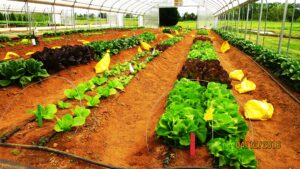
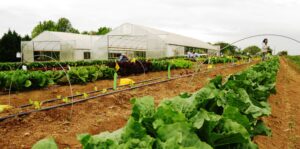
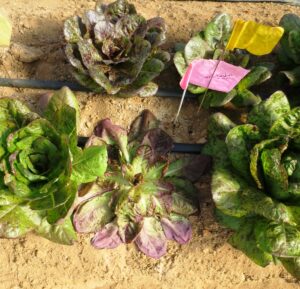
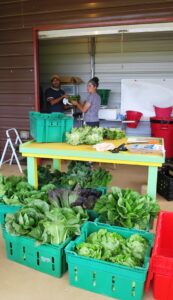
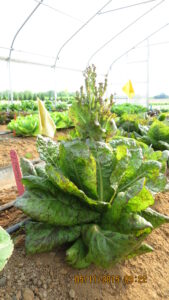
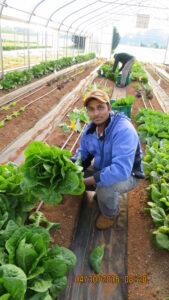
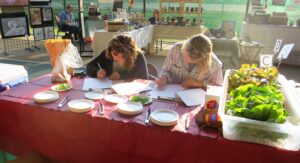
Suggestions for future research, demonstrations or trainings based on this study would include: 1) evaluating ways to manage heat stress in order to extend the spring/summer lettuce season, 2) comparing the effects of different high tunnel structures on crop yields, and 3) cultivar evaluation and plant breeding efforts for high tunnel systems.